X-Fi and the Elite Pro: SoundBlaster's Return to Greatness
by Derek Wilson on August 30, 2005 11:59 AM EST- Posted in
- Smartphones
- Mobile
Performance and Quality: Game Tests
For these tests, we will be looking at RightMark 3DSound 2.0 and Battlefield 2. With the possibility of twice the number of voices supported by Audigy, we can't do a direct comparison at some points. However, we will see how much impact going from 62 to 127 voices can have.Our test system included these components:
NVIDIA nForce 4 based motherboard
AMD Athlon 64 FX-55
1GB DDR400 2:2:2:8 RAM
NVIDIA GeForce 7800 GTX
120GB Seagate 7200.7 HD
Our RightMark tests show that the Audigy 4 Pro uses less CPU power per setting than the X-Fi. This was a little confusing at first, but we have our thoughts on why this happens. It seems to make sense to us that the X-Fi driver is more complicated than the Audigy driver. We therefore see slightly lower performance from the X-Fi card. With the X-Fi being brand new, driver improvements could also change the performance picture over time.
This performance issue should be different on the higher end X-Fi cards with games that support X-RAM. Unfortunately, we can't test this yet as no games we looked at have this ability. Storing uncompressed audio and not needing to run an MP3 or Ogg decoder in the background would help to significantly lighten the CPU load on most games. Note also how CPU usage increases nearly linearly with the number of voices used.
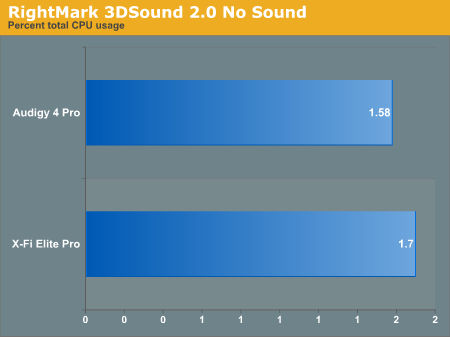
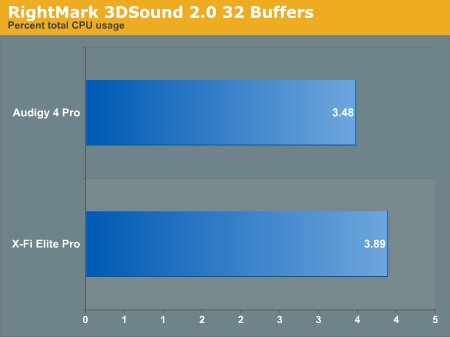
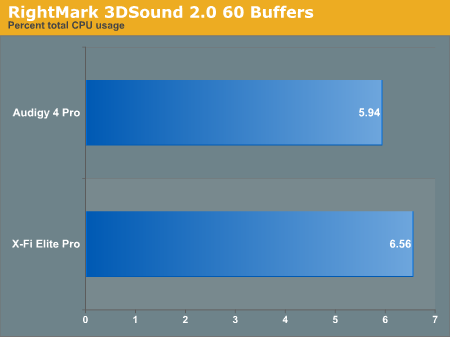
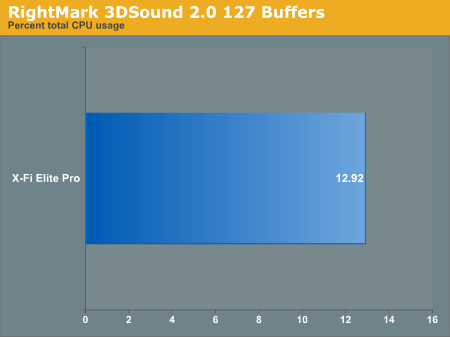
For Battlefield 2, we ran our usual test at medium quality settings at 1024x768. The Ultra High quality option in Battlefield 2 is only accessible with an X-Fi card (which likely means it employs more than 62 voices). As we can see, BF2 performance is consistent with our RightMark numbers. The X-Fi gives us just a little lower performance than the Audigy. It is nice to see that going from High Quality to Ultra High Quality on the X-Fi doesn't incur a significant performance penalty though.
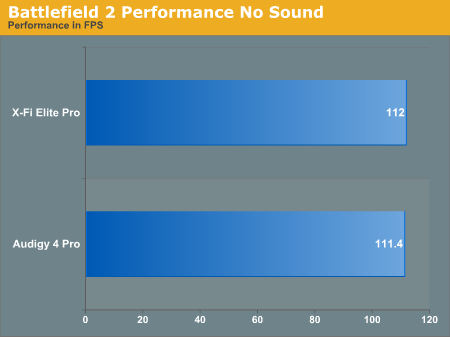
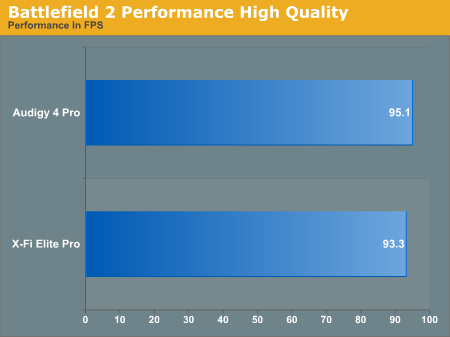
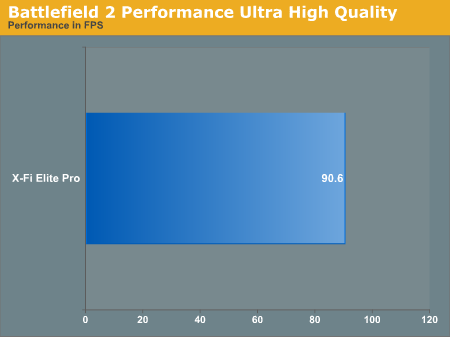










110 Comments
View All Comments
SDA - Tuesday, August 30, 2005 - link
>>Why do you post opinion like that and give no example? What is the point? >>Well, gee, I don't know. Why do you post your own opinion? Because we both like to post our opinions, of course. Everyone here does, else their posts wouldn't be there.
I agree that it's only fair to provide examples, so I have done so in my post. Beyond that, some general rules before buying ANYTHING:
- Determine what measurements and features you should be looking for. For example, with a CPU or GPU, you'd know you'd want to look for benchmarks in applications that you find yourself using most often, and what features you wanted or needed for those applications (SSE3? Multiple cores?). With a PSU, you would look for power quality (as determined by rail sag under load, AC ripple on all rails under load, etc.), ability to supply a given amount of power over a long period, whatever features you needed (modular cables? no fan?), component quality, and preferably a large amount of samples (there is often a great difference in quality from PSU to PSU from the same manufacturer).
- See if you can obtain some background knowledge in that field. It's a pain, I know, but it can come in really handy if you don't know what sources to trust or what features to look for. For power supplies, that means getting some basic power-specific EE knowledge (or asking an EE, heh); for CPUs or GPUs, that means trying to understand a little about how these processors work, what specific attributes are valuable in the applications you use, and how performance can be affected by the rest of the system.
- Find resources that you trust. You can identify these by whether or not the reviews or analyses in these resources take into account relevant measurements and features, and by how knowledgeable the reviewer seems in a specific area. A video card review that only does AquaMark and 3DMark should not be trusted (and the site or person that does it should be regarded with some suspicion in that field), and neither should a power supply review where the reviewer does not once mention ripple or do anything more than check the rails under light load with a Windows utility.
- Consider bias. This is not relevant at AT, where I at least trust the editors, but it is very important with some guy that spent a big chunk of money buying something. Of course someone who spent $500 on the latest and greatest processor is going to say that they like it, unless something is horribly wrong. How often do you hear people say that they think their stereos sound bad, that their computers are overpriced, that the PSU that they bought doesn't use the components they would expect at its price point? Now, I grant you, rational people do buy things BECAUSE they feel they are good choices, but there is almost always a significant degree of personal bias with some personal item.
(bias is also relevant when considering smaller or less trustworthy sites that may rely on manufacturers' goodwill, including but not limited to THG.)
A little long, I know, but maybe what little I know can help you with future purchases. If not, you don't have to read it, heh.
Eskimooo - Wednesday, August 31, 2005 - link
thanks for that. Much appreciated. Well, I did quite a research and virtually all reviews I came across including digit-life appreciate technology behind X-Fi. Most reviewers like even this much doubted Crystallizer feature, which is not obligatory and adjustable anyway.I do not believe Creative is so powerfull to exercise pressure on all the reviewers. So if both RMAA etc tests and subjective tests give positive results this card is probobly good and I think I am going to buy itEskimooo - Tuesday, August 30, 2005 - link
previous one posted to early, sorry. So my final question to all who listened to music using the X-Fi card and can compare it to other sound cards: Is there anything that would give more better features at the same quality level and at the same price? Please do not reply on Audigy or Live because X-Fi is a completely different card.DerekWilson - Tuesday, August 30, 2005 - link
It depends on what you are looking for, but in most cases I will have to disagree with you.The Gina 3G sells for $350 and does not off the quality of the X-Fi Elite Pro. Features include hardware 3D audio buffers, filters, and effects. Again Pro cards fall short (especially for gaming).
In fact, the only thing that I would give as an advantage of similarly priced professional audio solutions is balanced audio. This is a big advantage if the user intends to setup a completely balanced audio chain.
If I had to guess at a product that would best the X-Fi in terms of quality, I would have to point to the LynxTWO-B ... For which you would easily spend more than twice what the X-Fi Elite Pro costs. If you know of a pro card that you feel fits your claim, please point it out to us and we will do a comparison.
From what we have seen, your prescott/athlon64 comparison doesn't make much sense. If you take away the non-pro qualifier, we would still maintain that the X-Fi Elite Pro is the best sound card for any application at it's price point (unless you need balanced I/O). If you include no upper limit on price, then we will have to wait for our LynxTwo comparison before we shoot our mouths off too much.
So to recap, pro audio cards at the same price point or below offer fewer features, equivalent or lower sound quality, and similar recording capabilities (with the exception of balanced I/O).
SDA - Tuesday, August 30, 2005 - link
>>The Gina 3G sells for $350 and does not off the quality of the X-Fi Elite Pro. Features include hardware 3D audio buffers, filters, and effects. Again Pro cards fall short (especially for gaming). >>I never said anything about gaming, unless you're interested in recording gaming sessions. Anyway, you're relying on a logical fallacy-- specifically, a hasty generalization. More specifically, that the Gina 3G (a small sample) is representative of all pro audio cards in its price bracket.
>>If you know of a pro card that you feel fits your claim, please point it out to us and we will do a comparison. >>
Well, the E-MU 1212m is a rather capable card at half that price. The 1820 and 1820m are also capable pro cards. (Yes, I'm aware what E-MU is. The issue is capability for the price, not who owns what.) The Delta 1010LT is also an option, I guess, though it's a little dated now. There are also external options... Edirol equipment was fairly popular here last I checked (prefer separates, so I'm not entirely up-to-date). You're welcome to do your own research, of course-- that would be a good idea if you're going to make statements about what's the best.
>>From what we have seen, your prescott/athlon64 comparison doesn't make much sense. If you take away the non-pro qualifier, we would still maintain that the X-Fi Elite Pro is the best sound card for any application at it's price point (unless you need balanced I/O). If you include no upper limit on price, then we will have to wait for our LynxTwo comparison before we shoot our mouths off too much.
So to recap, pro audio cards at the same price point or below offer fewer features, equivalent or lower sound quality, and similar recording capabilities (with the exception of balanced I/O).>>
The comparison was solely to illustrate the issue of specialized comparisons. If you are willing to remove the "non-pro" qualifier, it is irrelevant.
I appreciate that the fine folks at AnandTech often have experience with as many as three or four different sound cards, but I must ask: exactly how many pro sound cards have you tested and reviewed? I don't mean "read the specs of", I don't even mean "measured the noise floor of", I mean given a full, comprehensive test. I sincerely doubt it is a very high number, and that you have and are utilizing the proper measurement equipment (and again, simple audio quality measurements say nothing but that everything out there today has obscenely good measurements).
Why do I doubt that? Well, ffs, you didn't even recognize the "24-bit Crystallizer" for what it was, relying instead on Creative's description that it clears up the high end and adds dynamic range. Someone who can't recognize a crude equalization's effect on the sound and who then regards said equalizer as a noteworthy feature is not someone I am inclined to trust for statements about professional audio.
If you're curious now about the Crystallizer, you might want to read Digit-Life's significantly better review, linked below.
http://www.digit-life.com/articles2/multimedia/cre...">http://www.digit-life.com/articles2/multimedia/cre...
yacoub - Wednesday, August 31, 2005 - link
"I appreciate that the fine folks at AnandTech often have experience with as many as three or four different sound cards, but I must ask: exactly how many pro sound cards have you tested and reviewed? I don't mean "read the specs of", I don't even mean "measured the noise floor of", I mean given a full, comprehensive test. I sincerely doubt it is a very high number, and that you have and are utilizing the proper measurement equipment (and again, simple audio quality measurements say nothing but that everything out there today has obscenely good measurements).Why do I doubt that? Well, ffs, you didn't even recognize the "24-bit Crystallizer" for what it was, relying instead on Creative's description that it clears up the high end and adds dynamic range. Someone who can't recognize a crude equalization's effect on the sound and who then regards said equalizer as a noteworthy feature is not someone I am inclined to trust for statements about professional audio. "
Well this is what happens when you have a PC hardware review site in the day and age where the hardware is running out of 'hot new features' and starting to overlap with professional grade equipment in order to justify the pricing.
It's also what happens when you get a review site reaching out into random other areas like digital cameras - realms where there are other sites that exist solely to do such reviews and will obviously do them to a much finer degree. As you get into the realm of professional audio products with the features of PC hardware audio products, it necessitates one of two things: Delving into the field of pro audio equipment to a large degree, or not making comparisons to items in a field one isn't highly knowledgeable about. :)
yacoub - Wednesday, August 31, 2005 - link
Ah, I see you say as much here:"Derek - The concern I have is that your review, as it stands, is a ringing endorsement for a product in a market you do not fully understand. The users who rely upon Anandtech as their only source for this type of reccomendation are likely to purchase something like this, even though there are a wide variety of competitive solutions out there for a quarter of the price. I feel you should at the least post a disclaimer that your audio review process is a work in progress and make it very clear that you do not fully understand the market that the X-Fi is being marketed to, nor have adequate experience with competitive audio solutions. "
Very well put!
DerekWilson - Wednesday, August 31, 2005 - link
We've played with a few different cards extensively, in cluding the TerraTec EWS88 MT the M-Audio Delta 1010 and the EMU 1212 ... We didn't run any RMAA tests on them, as they were used for listening and recording. From our experience, I can say I'd rather have the X-Fi Elite Pro for a non-balanced setup. Currently I have an external ADC for converting balanced line-ins to ADAT and run digital audio to the computer and I use the Gina 3G for recording the ADAT signal.Regaurdless of our experience, we haven't done indepth electrical analysis of these parts yet. It is our intention to test other consumer, semi-pro and pro cards and compare them. We drew our assessment of the X-Fi from our experience with hardware and the in-depth tests we have done so far.
As far as the Crystallizer goes, we are talking about more than one effect if Digit-Life is correct. Yes, there's equalization, but that's not all. I wasn't expecting multiband compression to be added which (as digit-life points out) decreases the dynamic range of the original signal. We will certainly be speaking with Creative about this (there are other things that could be going on that an RMAA test doesn't determine), and if our analysis leads us to the same conclusion we will certainly have some things to say about it. We certainly noticed the general increase in dB level though ... If I didn't mention it, when comparing crystallizer audio with unmodified audio we decreased the volume to match.
On top of that, the word noteworthy carries a positive connotation. If you mean only to say that we noted the Crystallizer as a feature and tested it, that's fine. Beyond that, our assessment was that the crystallizer had limited application to some audio sources that were already subpar. I would say we were not wrong.
At the same time, we are still finding our way in PC audio. We recognize we have some room for improvement and appreciate any direction and help we can get. We will expand our coverage to include indepth signal analysis on features like the Crystallizer. There are difficulties in going down this route, and it is hard to correctly talk about the value of psychoacoustic functions or environmental effects from such analysis. We haven't gone there yet because it is like opening a can of worms. Any suggestions are welcome.
Thanks very much for taking the time to bring all of these issues to our attention.
Derek Wilson
SDA - Wednesday, August 31, 2005 - link
Why, jooc, would you rather have the Elite Pro? Just what listening equipment are you using (I'd really like to know this part), and what tests have you performed with them (other than introductory spec measurement)?Noteworthy does carry positive connotations, but then the fact that your review sees it as a feature that can be useful for some does mean to me that you've classified it as a noteworthy feature when, in reality, it is utterly useless (anything that can benefit from it can benefit from a better, simpler software EQ that you can carry with you from card to card).
I tend to agree with Reflex here. I understand and appreciate that you guys are trying, and you'll notice I haven't made any stupid accusations about bias, but the fact is that this is an unqualified endorsement. If you're still finding your way in PC audio, you should be a little more cautious about making sweeping general statements.
DerekWilson - Wednesday, August 31, 2005 - link
I would rather have an Elite Pro because I also like to play games and movies as well as record and listen to music. I do to perfer my external ADC for recording, and would probably rely on it instead of the soundcard itself.For listening, I generally stick with my Sony MDR-7509 headset. I also have the Sennheiser HD580 that I use to audition sound hardware. The reason I stick with the Sony gear for general listening is due to my environment. I can turn everything off when I need to do a noise test or listen closely to something, but the lab with all the computers and workstations running is not a quiet environment. I realize that open air headests will reproduce (especially) the low end in a more appropraite manner, so I do listen with them, but I know the sound a little better on the MDR-7509s as I've been using them for a long time.
I am planning on picking up the HD650 as I've heard great things about them.
The tests I've performed with them include recording and editing audio on them. I've used each of the solutions I mentioned in my home rig before I moved to lightpipe. I'm definitely not saying they don't get the job done well. And if that's all you want a sound card for, then I'd certainly go with one of those solutions over the X-Fi. Likewise, if all you are doing is stereo audio listening then one of the other solutions is still a better choice.
The advantage of the X-Fi (and I'm sorry if I didn't make this clear in the article) is that it is capable of high quality recording, high quality playback, EAX 2+ with 127 voices, has lots of analog and digital I/O, and generally meets any requirement anyone could have from a consumer or semi-pro sound card (except, again, balanced I/O). But $400 is still too much to pay for this solutioin.
Doing something like a double blind subjective study on audio is difficult. People that don't know how to listen won't be any help because even if they hear a difference they won't know how to describe it very well. People who do know what they are talking about are hard to come by in volume. Don't get me wrong, we'd love to do something like this. But we just don't have any idea how to work out the logistics. Suggestions are welcome.
Also, I appreciate the suggestion to avoid general statements about the goodness of something. It is a good suggestion even in cases where we know everything about everything in detail. There are always surprises and erring on the side of caution is the best way to go. We will be more careful in the future.
Derek Wilson